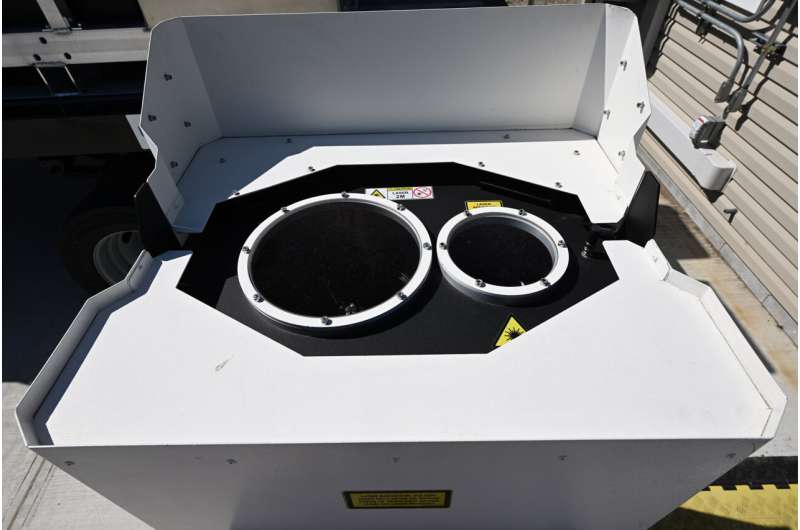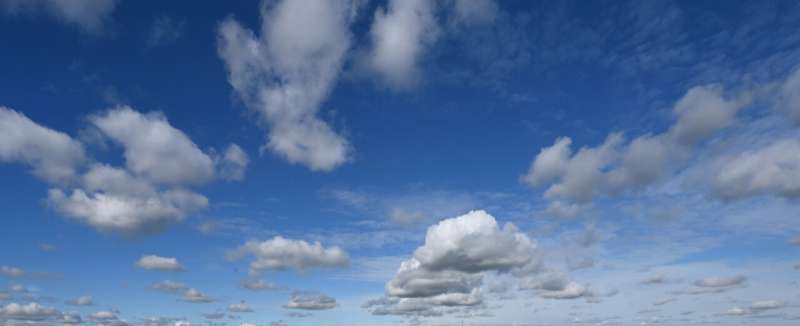This article has been reviewed according to Science X's editorial process and policies. Editors have highlighted the following attributes while ensuring the content's credibility:
fact-checked
peer-reviewed publication
trusted source
proofread
Scientists demonstrate high-resolution lidar sees birth zone of cloud droplets, a first-ever remote observation

A team led by atmospheric scientists at the U.S. Department of Energy's Brookhaven National Laboratory has demonstrated the first-ever remote observations of the fine-scale structure at the base of clouds. The results, just published in npj Climate and Atmospheric Science, show that the air-cloud interface is not a perfect boundary but rather is a transition zone where aerosol particles suspended in Earth's atmosphere give rise to the droplets that ultimately form clouds.
"We are interested in this 'droplet activation zone,' where most cloud droplets are initially formed at the cloud base, because the number of droplets formed there will affect the later stages and properties of the cloud—including how much sunlight a cloud reflects and the likelihood of precipitation," said Brookhaven atmospheric scientist Fan Yang, the first author on the paper.
"If there are more aerosols in the atmosphere, clouds tend to have more droplets, but the droplets will each be smaller, which means they can reflect more sunlight," Yang said. "This might help to cool our warming Earth," he noted.
But to accurately predict the impacts of these aerosol-cloud interactions on the climate system, scientists need a way to measure cloud droplet number concentrations—without having to fly up into lots of clouds to collect samples.
"This remains one of the biggest challenges in our field," Yang said.
The new remote-sensing measurements and method provide a novel way to estimate droplet concentration, which will enable scientists to gain insight into how changes in atmospheric aerosol levels could affect clouds and climate.
Seeing clouds in finer detail
Atmospheric lidars—which send laser beams into the atmosphere and measure the signals of light backscattered from molecules, aerosols, and cloud droplets in the atmosphere—have been widely used to measure the distance to the cloud base. But traditional lidars can't resolve detailed structures within the cloud base because they typically have a resolution of 10 meters or more.
"Ten meters is like the height of a building," said Yang, noting the ability of this scale to detect large objects. "But to know how many floors or windows that building has, you'd need much finer resolution."
To see details within the cloud base, the Brookhaven team worked with colleagues at Stevens Institute of Technology (SIT) and Raymetrics S.A. to build a new kind of lidar. Their device, described in an earlier publication, is a time-gated, time-correlated, single-photon counting lidar (T2 lidar) with a resolution down to 10 centimeters. That's two orders of magnitude higher resolution than traditional atmospheric lidars.
"With such a high resolution, the T2 lidar observations reveal the transition zone where aerosol particles absorb water vapor to be transformed into cloud droplets," Yang said.
"We used our unprecedented fine-scale T2 observations of the cloud base region to develop a theoretical model to estimate cloud droplet concentration based on T2-measured backscatter signals," he added.

One unique feature of the T2 lidar is the application of the time-gating technique—forcing the detector to open its "eye" to make measurements in a narrow observational window in the atmosphere.
"This time gating allows us to 'look' at a specific region of interest within the cloud. This is different from a conventional lidar, where the lidar's 'eye' is generally open, being ready to capture back-scattered photons nearly all the time," Yang said.
By setting the time delay between the T2 lidar's laser pulse and the eye opening to different time intervals, the scientists can sample signals at different regions through the cloud.
The device also has a very high repetition rate, firing 20,000 laser pulses per second.
"We can learn about cloud properties from how the back-scattered signals are distributed within the observational window," Yang said.
Application for cloud chamber observations
To make the technique truly useful for accurate remote real-world measurements, the T2 lidar will have to be properly calibrated. That is, scientists need to fully understand how the measured light signals match up with the real-world cloud properties so they can fine-tune the computational algorithms they've written to relate one to the other.
Traditional lidar measurements of atmospheric clouds are sometimes cross-checked and calibrated by flying an aircraft through clouds to capture droplet samples. Scientists try to calibrate the lidar readings with the "true" properties of droplets from the in-situ aircraft measurements.
"The problem is, the remote sensing and in-situ measurements are usually not co-located," Yang said. That is, it's highly unlikely that an upward pointing lidar with a coarse resolution and a plane flying horizontally to collect a thin sample stream are gathering data on the same part of the cloud at the same time.
To improve on this situation, the Brookhaven and SIT team is using a technique similar to what they used in the T2 lidar to build a lidar with even finer resolution—down to one centimeter. By using this higher-resolution lidar to make observations in a lab-based cloud chamber, they'll be able to match up backscattering signals with in-situ measurements of cloud physical properties taken at the same time and in the same location.
"Then we can take the lidar back out into the real atmosphere and be more confident in how our lidar measurements relate to cloud properties such as droplet number, concentration, and distribution," Yang said.
"This is just a start," Yang noted. "Our study highlights the benefits of applying advanced technologies to observe atmospheric clouds at submeter scales, which can open up new avenues for advancing our understanding of cloud microphysical properties and processes that are crucial to weather and climate."
More information: Fan Yang et al, A single-photon lidar observes atmospheric clouds at decimeter scales: resolving droplet activation within cloud base, npj Climate and Atmospheric Science (2024). DOI: 10.1038/s41612-024-00644-y
Journal information: npj Climate and Atmospheric Science
Provided by Brookhaven National Laboratory





















